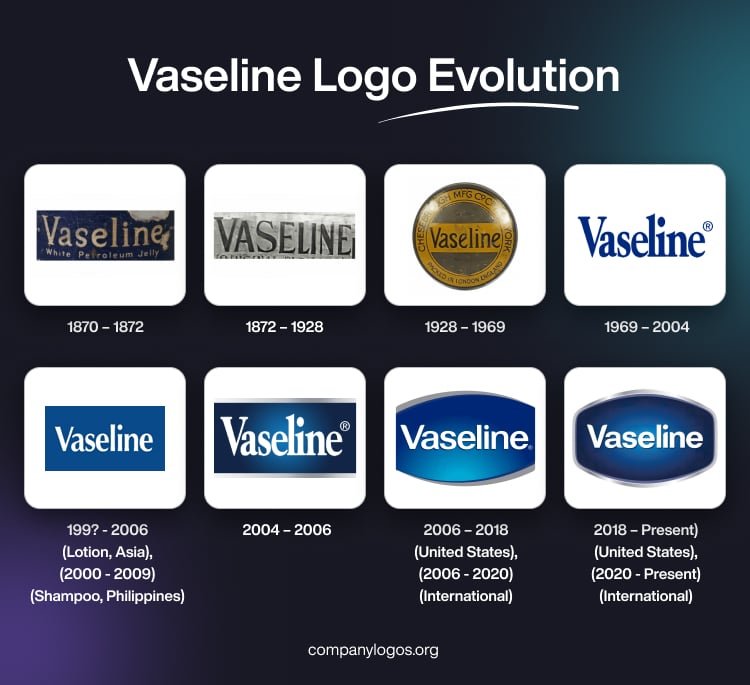
Vaseline is an American skincare brand that manufactures a range of products based on petroleum jelly. It was founded in 1870, when chemist Robert Chesebrough introduced his petroleum jelly product in Brooklyn, New York. Currently owned by Unilever, the brand comprises products such as body creams, soaps, lotions, deodorants, and cleansers. The article explores the various logo variants of Vaseline, among other details of the company, over the years.
The Genesis of the Vaseline Logo (1870 – 1872)
The original Vaseline logo featured the word “Vaseline” in large, bold white or slightly golden letters. It was often accompanied by the phrase “White Petroleum Jelly”. The thin and curly letters, especially the “e” and “s”, had curves. The background was a deep, textured blue, which evoked a sense of trust and medicinal reliability. The serif font was authoritative and straightforward and reflected the product’s clinical roots.
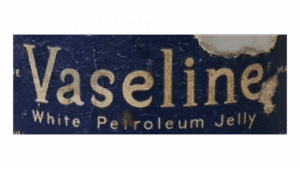
(1872 – 1928)
The first logo change showed a more minimalist design, with “VASELINE” rendered in monochrome, metallic, uppercase letters. The blue backdrop was removed, which led to a stark, modern impression that focused solely on the brand name. The weathered look of the letters in small serifs hinted at the brand’s heritage and durability.
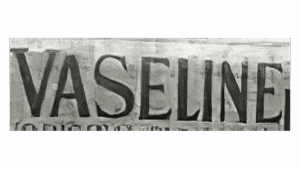
(1928 – 1969)
The logo took on a golden-yellow colour where the brand name was displayed on a yellow stripe using a bold, elongated font, centred within a circular badge. The circular border mentioned “CHESEBROUGH MFG CO.” and “PACKED IN LONDON ENG. AND” to highlight its manufacturing origins and growing international presence. This design exuded a regal, classic feel and emphasised Vaseline’s reputation and global reach.
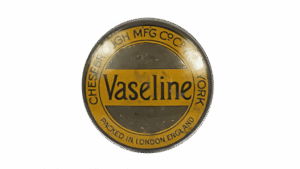
(1969 – 2004)
In 1969, Vaseline embraced a cleaner and more contemporary look without the roundel. The logo featured the brand name in a crisp navy-blue sans-serif font on a white background, with smooth, rounded letters. This shift reflected the brand’s emphasis on purity, gentleness, and modernity. The design’s simplicity and clarity made it easily recognisable and memorable.
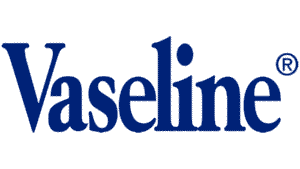
(199? – 2006) (Lotion, Asia), (2000 – 2009) (Shampoo, Philippines)
Another logo was devised to appear on specific Vaseline products, namely, lotion and shampoo, in Asia. Devoid of serifs, the logo featured the brand name in white title case against a deep blue background for visual clarity.

(2004 – 2006)
The logo of 2004 introduced a gradient from deep to lighter blue, thereby creating a three-dimensional effect. The bold, white “Vaseline” text featured a subtle shadow to add depth and a sense of sophistication. This update aimed to communicate the brand’s reliability and signalled a move toward a more dynamic, contemporary identity.
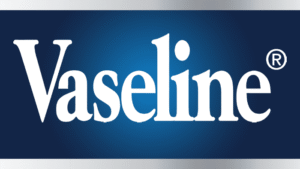
(2006 – 2018) (United States), (2006 – 2020) (International)
In 2006, the logo adopted a curved, container-like shape, with a richer blue gradient and a luminous centre. The logotype appeared in the middle of the arched design using a classy sans-serif typeface. This design with a flat grey outline showed the physical packaging of Vaseline products and emphasised purity and innovation. The spotlight effect and curved form made the logo more visually engaging and modern.
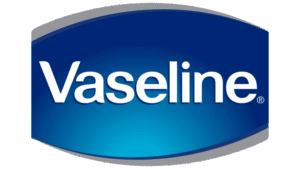
(2018 – Present) (United States), (2020 – Present) (International)
The current Vaseline logo features a sleek, silver-edged design with a deep, uniform blue background. The ellipse-shaped logo shows the brand name in white title case against a subtle gradient. Further, the metallic edge of the ellipse adds a modern, tech-inspired touch. This design balances timelessness with contemporary appeal. It ensures instant recognition and reinforces Vaseline’s status as a trusted global brand.
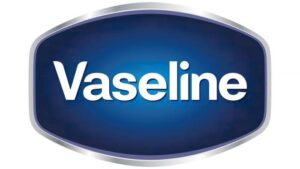
The Elements of the Vaseline Logo
Font
The visual identity of Vaseline uses a simple, traditional, and stable sans-serif typeface. It is similar to the fonts of Langtone Heavy and Hypersans. The letters in the logotype appear vivid and dynamic, thanks to the play of a light grey shadow and a slight gradient.
Colour
The Vaseline logo employs a blue and white colour palette to convey attributes, such as professionalism, expertise, and reliability. They reflect the brand as trustworthy and protective.
The History of Vaseline
The history of Vaseline begins in 1859 with a young chemist from New York called Robert Augustus Chesebrough. At the time, Chesebrough was searching for new opportunities after his previous work involving clarifying kerosene from whale oil became obsolete due to the rise of petroleum. He travelled to the oil fields of Titusville, Pennsylvania, where he observed oil workers were using a residue called “rod wax” to heal cuts and burns.
Chesebrough was intrigued by the healing properties of this substance. Over the next five years, he refined and purified the material and turned it into a colourless and odourless jelly. By 1865, he had patented the process for making petroleum jelly. In 1870, Chesebrough began marketing his new product under the brand name “Vaseline”. This name was believed to be derived from the German word Wasser (water) and the Greek word elaion (oil). The first official reference to Vaseline appeared in a U.S. patent in 1872.
To promote Vaseline, Chesebrough used bold marketing tactics. He would publicly injure himself, apply Vaseline to the wounds, and demonstrate their rapid healing. He also distributed free samples to doctors and the public to build trust about the effectiveness of the product. By 1875, Vaseline had become a household staple in the United States, with sales reaching a jar a minute.
Vaseline’s reputation quickly spread beyond the U.S. In the late 1800s, it gained international acclaim and even reached Queen Victoria, who reportedly used it for her dry skin. Chesebrough was knighted in 1883 for his contribution to skin health. Factories were established in Europe, Canada, and Africa to meet the growing demand. During World Wars I and II, Vaseline became an essential item in military first-aid kits, as it was valued for its ability to protect and heal wounds. Its versatility and safety made it a trusted remedy for a wide range of skin issues.
In 1955, the Chesebrough Manufacturing Company merged with Pond’s to form Chesebrough-Pond’s. This company was later acquired by Unilever in 1987, which brought Vaseline into the portfolio of one of the world’s largest consumer goods companies. The 1960s marked a significant shift as Vaseline expanded beyond petroleum jelly. In 1969, the brand introduced Vaseline Intensive Care Lotion by leveraging modern technology to deliver superior moisturisation in a light, non-greasy formula.
Today, Vaseline remains a global leader in skin care. Its product range includes the original petroleum jelly as well as lotions, creams, and lip care products. The brand is celebrated for its commitment to accessible, effective skin healing and care, with the original “wonder jelly” still at the heart of its offerings.
The enduring success of Vaseline is rooted in Chesebrough’s curiosity, innovation, and commitment to quality. From a byproduct of the oil industry to a household name, Vaseline has maintained its reputation for healing and protecting skin for over 150 years.
Interesting Facts About Vaseline
- Vaseline was discovered by Robert Chesebrough in 1859 after he noticed oil workers using a gooey residue called “rod wax” from oil rig pumps to heal their cuts and burns. He refined this substance into petroleum jelly, which he patented in 1872.
- The name “Vaseline” is believed to be a combination of the German word Wasser (water) and the Greek elaion (oil) to reflect the product’s composition and purity.
- Chesebrough was one of the first to use free samples as a marketing strategy. He demonstrated Vaseline’s healing properties by applying it to his injuries in public. This helped build trust and demand for the product.
- Queen Victoria was a fan of Vaseline and used it to heal her dry skin. In recognition, she knighted Robert Chesebrough in 1883. It was a rare honour for a chemist and businessman at the time.
- By the early 1900s, Vaseline had become a global brand with factories in Europe, Canada, and Africa. It was trusted worldwide as a safe and pure product for skin healing and protection.
- Vaseline accompanied Commander Robert Peary on the 1909 North Pole expedition because it did not freeze and protected his skin in extreme conditions. During both World Wars, it was a staple in soldiers’ first-aid kits. They used it to treat cuts, burns, and sunburns. It was so valued that soldiers sometimes bartered with it.
- The petroleum jelly was triple-purified to remove impurities, which made it suitable for all skin types and safe for medical use.
- Although originally marketed as a medicinal product, Vaseline’s main benefit is forming a protective layer that keeps wounds clean. It did so by preventing grime and bacteria from entering, rather than having any curative power itself.
- Vaseline has been helping heal and protect skin for over 150 years and remains a trusted household name worldwide. It is now owned by Unilever and offers a broad range of skincare products beyond petroleum jelly.
- In many countries, “Vaseline” has become a generic term for petroleum jelly. This shows its deep penetration into everyday life and language.
Finally
The Vaseline logo has undergone a remarkable transformation over more than 150 years. The logo variants show shifts in design trends, consumer expectations, and the brand’s expanding global footprint. The logo changed from its authoritative, medicinal origins to its current sleek, modern identity. It has consistently embodied the core values of Vaseline – trust, healing, and care. Today, the Vaseline logo stands as an instantly recognisable symbol of skincare excellence.